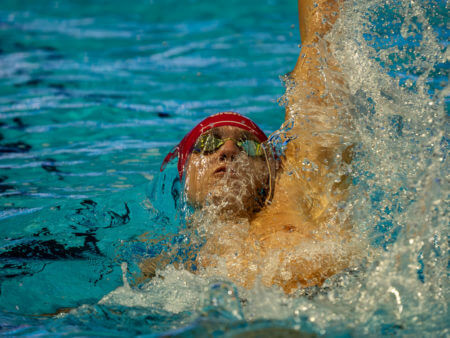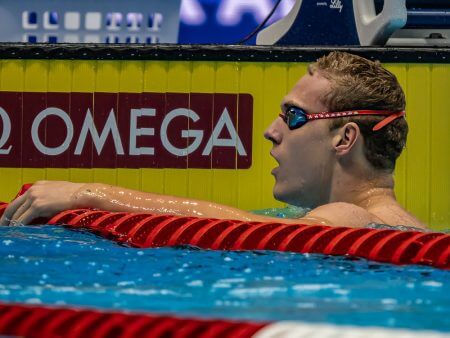Another Record-Breaking Surge Makes Maximus Williamson Male High School Swimmer of the Year
Entering his junior-year high school state meet, Maximus Williamson had conducted his research on the 13-year-old national high school record he was chasing. When David Nolan had clocked 1:41.39 back in 2011, the swim was considered one of the finest ever by a pre-college swimmer. It was faster than the winning time at the NCAA Championships that year, the next year and all but two seasons before that (one with Ryan Lochte and the other with polyurethane suits), and during his own college career, Nolan would become the first man to ever break 1:40 in the event.
Williamson wiped out that record in dramatic fashion to kick-start an incredible day in which he would also break the scholastic mark in the 100 freestyle, breaking 42 for the first time in a high school meet, and lead Keller High School to two national marks in relays. With two seniors on the squad, Keller finished the meet by edging the national mark in the 400 free relay by one hundredth, and Williamson called the moment one of his favorite in his swimming career.
Keller won its second consecutive state title in boys’ swimming and a national team championship, and Williamson’s individual efforts earned him the honor of National High School Male Swimmer of the Year.
Already considered one of the most talented pre-college swimmers in the United States, Williamson was propelled at the high school meet by feelings of pride and camaraderie as raced alongside his high school teammates, even though he had only arrived at Keller as a sophomore.
“It’s always an honor because you’re swimming next to basically family,” Williamson said. “I see them more than my real brothers because I’m always at the pool. If I’m not at pool, I’m at school, and then they’re still at school. So, I mean, we’re basically just always together. And I think that’s what’s so special about high school (swimming), having fun and hanging out with your people.”
Record-Breaking Star

Maximus Williamson — Photo Courtesy: Peter H. Bick
The high school performance was a snapshot of Williamson’s remarkable capabilities already showcased on the national and international levels. When he turned 17, he was the owner of four 15-16 National Age Group records, the most notable of which was a 400-yard IM performance in which he clobbered a Michael Phelps record that lasted for 20 years by more than two seconds, getting down to a time of 3:39.83.
Williamson’s 17th birthday coincided with the start of a World Junior Championships in Netanya, Israel, in which he won seven medals including individual golds in the 100 freestyle and 200 IM. Most impressive among his efforts were 47.78, 47.74 and 47.57, all in golden U.S. relay efforts.
And Williamson already owns three 17-18 NAG marks, with his high school 200 IM doubling as the overall age-group mark, a 48.38 100-meter free recorded in his world-junior-title-winning swim and a remarkable 1:31.37 effort in the 200-yard free, a time already quick enough to qualify for an NCAA Championships A-final.
Chasing records, Williamson said, has been a significant motivating force during his career. “The way I see it is if that other people can do it, I can do it. I’m competitive. I’m a competitive person. I don’t really like being second or losing anything,” he said. “I want to be the first. I think that’s why I’m super successful in the sport because I want it so bad. That’s why I’m able to finish races like I do. My parents and everyone always tell me that it’s all heart.”
Williamson believes his competitive instincts come from his family, with both parents serving in the military. “Everything’s like, ‘Go, go, go. It’s OK if you fall but, get back up.’ He has twin brothers four years younger; both used to swim, and both will follow Maximus to Keller High School, so he believes he must establish a good reputation for his family before their arrival.
In the pool, Williamson learned how to truly train hard when he was a freshman training with senior distance swimmer Mason Edmund, who now competes for Ohio State. “He’s the hardest worker I’ve ever seen in my life,” Williamson said. “We would touch the wall, and he would scream at me, like, ‘You can do better than that. Come on!’ Then I’ll beat him on the last one, and he’d be like, ‘Where was that at the whole practice?’
Now, Williamson’s training group of about 40 swimmers under coaches Jason Walter and Dan Balint at Lakeside Aquatic Club stokes his competitive instincts during training alongside swimmers such as Cooper Lucas, River Paulk, Riccardo Osio and Maxwell Stanislaus, all fellow members of Keller’s national-title-winning high school team. Williamson credits Walter and Balint with cultivating the collaborative, supportive environment required for elite swimming.
“Jason and Dan, no matter what, they’re always yelling at us from the side of the pool and just encouraging the whole group. They’re encouraging the whole group to make it that team atmosphere of pushing each other,” Williamson said. “They’re the ones outside the circle feeding us information and feeding us motivation. And then inside the circle, the swimmers take that information and multiply it.”
Embracing Competition
The one blip in Williamson’s rapid ascension through the swimming ranks came at the least opportune moment, the 2024 U.S. Olympic Trials. His efforts at the World Junior Championships nine months prior had put him in the Olympic conversation, particularly with six swimmers likely to qualify for the Games as part of the U.S. men’s 400 free relay, but Williamson swam more than a second slower than his best time in the 100 free to finish in a tie for 29th place. He rebounded to qualify for the semifinals of the 200 IM but ended up finishing just a tenth outside of the top-eight.
Looking back on that selection meet, which featured the biggest crowds to ever watch the sport in-person, Williamson said he had dealt with illness beforehand, and during the meet, he was “in that droopy stage of after sickness.”

Maximus Williamson — Photo Courtesy: Peter H. Bick
Entering the meet, he felt his chances of performing well were 50-50, and he briefly considered skipping the meet completely, but given his goals for the remainder of his swimming career, he was not going to back down from the moment. “I swam there for the experience, because I know for sure I’ll be someone at 2028 Trials. I know that I’ll be at my best, probably ever, at 2028 Trials,” Williamson said.
“I learned that no matter your certain situations, you can still perform. Even though I felt like crap for most of the time, I was still not swimming that bad for the way I felt, and I was at Trials. Only a select few people get Trials, and even fewer actually swim well there.”
His Trials disappointment did not shake Williamson’s self-confidence and his eagerness to embrace further challenging situations. Reflecting on his time representing the U.S. at the World Junior Championships, Williamson called the environment “absurd” in a way that lifted his performances. “There’s no way that I can fail with all of these people around me,” he said.
That mindset of seeking challenge and opportunities for growth came into play when Williamson was considering his options for college swimming. He would have been the instant superstar at nearly any swimming program, but he chose to embrace a partnership with fellow top recruit (and U.S. Olympian) Thomas Heilman at the University of Virginia, believing that setup would provide him the optimal opportunity for continued growth. Sharing the spotlight was of no concern.
“We’re gonna constantly be battling each other in practice, and that’s just what I like. That’s just down my alley. I’ll be constantly competing with someone who’s also trying to get better, just like me,” Williamson said. “I’m drawn to that. I like competition. I like when someone challenges me and says I can’t do this or I can’t beat them.”
An extra 50 free race off the blocks at end of practice? “I will never be one of those people to say no,” Williamson said. “I always feel like, ‘OK, let’s go.’”








